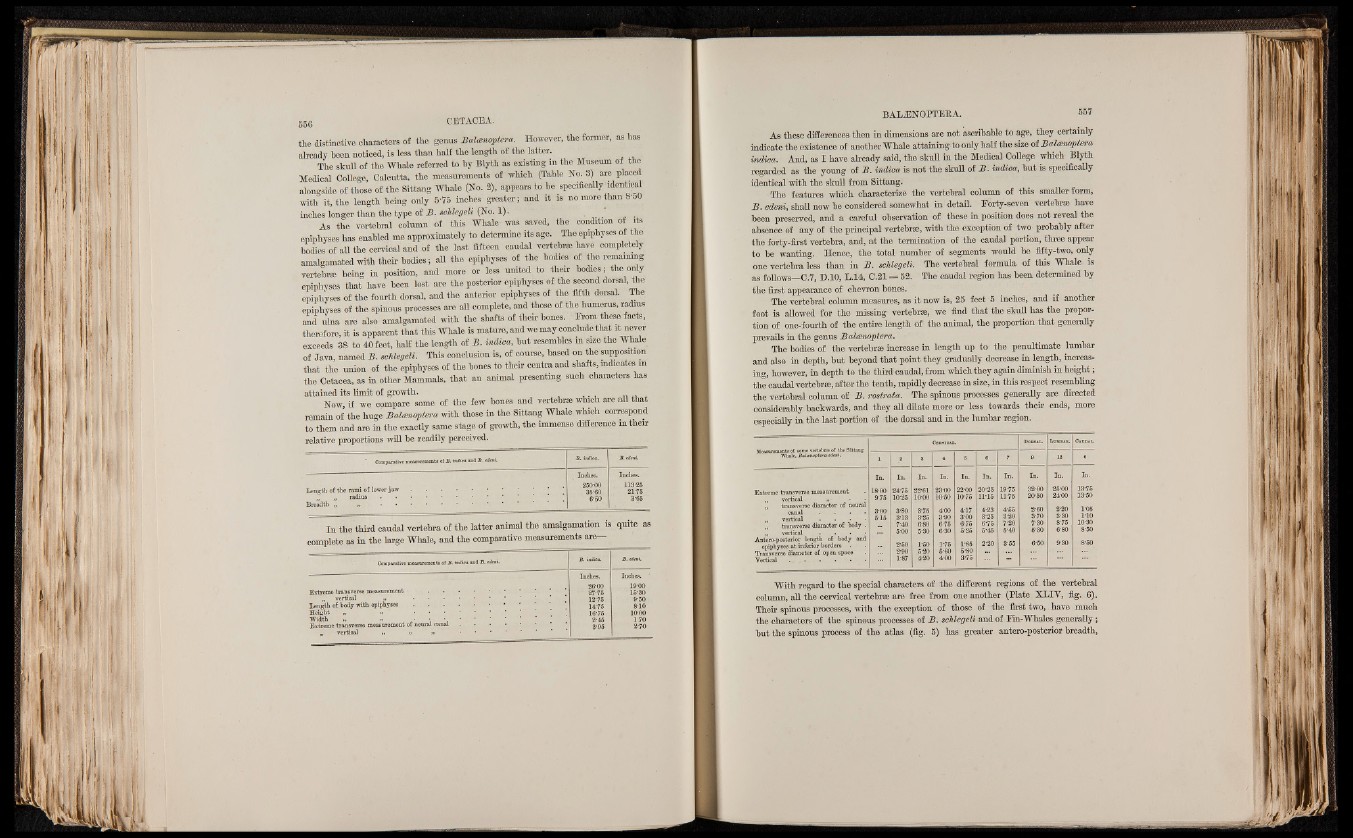
the distinctive characters of the genus Balcemptera. However, the former, as has
already heen noticed, is less than half the length of the latter. . . .
The skull of the Whale referred to hy Blyth as existing in the Museum of the
Medical College, Calcutta, the measurements of which (Tahle No: 3) are placed
alongside of those of the Sittang Whale (No. 2), appears to be specifically id e n f a l
with it, the length heing only 6'7B inches greater; and it is no more than 8-BO
inches longer than the type of B. schlegeli (No. 1). _
As the vertebral column of this Whale-was saved, the condition of its
epiphyses has enabled me approximately to determine its age. The epiphyses of the
bodies of all the cervical and of the last fifteen caudal vertebrae have completely
amalgamated with their bodies; all the epiphyses of the bodies of the remaining
vertebrse heing in position, and more or less united to their bodies; the only
epiphyses that have heen lost are the posterior epiphyses of the second dorsal, the
epiphyses of the fourth dorsal, and the anterior epiphyses of the fifth dorsal. The
epiphyses of the spinous processes are all complete, and those of the humerus, radius
and ulna are also amalgamated with the shafts of their hones. Erom these facts,
therefore, it is apparent that this Whale is mature, and we may conclude that itnever
exceeds 38 to 40 feet, half the length of B. mdica, hut resembles m size the Whale
of Java, B. schlegeli. This conclusion is, of course, based on the supposition
that the union of the epiphyses of the hones to their centra and shafts, indicates in
the Cetacea, as in other Mammals, that an animal presenting such characters has
attained its limit of growth. , ,
Now, if we compare some of the few hones and vertebrae which are all that
remain of the huge Balcemptera with those in the Sittang Whale which correspond
to them and are in the exactly same stage of growth, the immense difference in their
relative proportions will be readily perceived.
‘ Comparative measurement» of B. indica and B. edeni. B. indica. B. edeni.
Length o f the rami of lower jaw . . . • • • • •
; „ radios
Breadth „ . >» • • | .................................................
Inches.
250-00
. 35-60,,
6-50
Inches.
. 113-25
2175
3-65
amation is
nts are—
In the third caudal vertebra of the latter animal the amalg
complete as in the large Whale, and the comparative measureme
quite as
Comparative measurements of B. indica and B. edeni. B. indica. B. edeni.
„ vertical » » » ■
Inches.
26-00
27-75
12-75
14-75
16-75
2-46
3-95
Inches. 1
1900
15-30
9-50
810
10:00
1-70
2-70
As these differences then in dimensions are not ascribable to age, they certainly
indicate the existence of another Whale attaining to only half the size of Balcemptera
Mica. And, as I have already said, the skull in the Medical College which Blyth
regarded as the young of B. indica is not the skull of B. indica. hut is specifically
identical with the skull from Sittang.
The features which characterize the vertebral column of this smaller form,
B. edeni, shall now be considered somewhat in detail. -Forty-seven vertebrse have
been preserved, and a careful observation of these in position does not reveal the
absence of any of the principal vertebrse, with the exception of two probably after
the forty-first vertebra, and, at the termination of the caudal portion, three appear
to be wanting. Hence, the total number of segments would be fifty-two, only
one vertebra less than in B. schlegeli. The vertebral formula of this Whale is
as follows—0.7, D.10, L.14, 0.21 = B2. The caudal region has been determined by
the first appearance of chevron bones.
The vertebral column measures, as it now is, 25 feet 5 inches, and if another
foot is allowed for the missing vertebrae, we find that the skull has the proportion
of one-fourth of the entire length of the animal, the proportion that generally
prevails in the genus Balcenoptera.
The bodies of the vertebrae increase in length up to the penultimate lumbar
and also in depth, hut beyond that point they gradually decrease in length, increasing,
however, in depth to the third caudal, from which they again diminish in height;
the caudal vertebrae, after the tenth, rapidly decrease in size, in this respect resembling
the vertebral column of JB. rostrata. The spinous processes generally are directed
considerably backwards, and they all dilate more or less towards their ends, more
especially in the last portion of the dorsal and in the lumbar region.
Whale, Balemoptera edeni.
Measurements of some vertebrse of the Sittang
Ceevical DOBSAL. LUMBAB. Causal.
l 2 8. * 5 » ' 7: 9 12 6
In. In. In. In. In. In. In. In. In. B
18-00 24-75 22-61 2300 22-00 20-25 19-75 32-00 25-00 13-76
975 10-25 10-00 10-50 10-75 20*50 24 00
„ transverse diameter of neural
3-80 3-75 400 417 4-23 4-55 2-60 2-20 1-05
vertical 3-25 3-90 3-00 3-25 3-20 3-70
7-40 6-80 675 6-75 6-75 7-20 7-30 8-75
5-00 5-30 6-30 6-25 5*45 5*30
Antero-posterior length of hody and
epiphyses at inferior borders . 2-50 1-50 1-75 1-85 2-20 3-55 6-60 9-30 8-50
5"80
Vertical . . . . . 1-87
With regard to the special characters of the different régions of the vertebral
column, all the cervical vertebrse are free from one another (Plate XLIY, fig. 6).
Their spinous processes, with the exception of those of the first two, have much
the characters of the spinous processes of B. schlegeli and of Pin-Whales generally ;
hut the spinous process of the atlas (fig. 5) has greater antero-posterior breadth,